JOSEF EBERZ (Limburg an der Lahn 1880 - 1942 München) Küste bei Ragusa, 1923 Öl/Karton, 34 x 42,5 cm signiert J. Eberz und datiert 23 Ausstellungsetikett Galerie Neue Kunst Hans Goltz München, N° P.459, ausgestellt 1923 abgebildet in Expressiver Realismus in Deutschland, Wien 2017, S. 12, Nr. 17 Provenienz: Auktionshaus Neumeister München 2010, Kunsthandel Widder Wien SCHÄTZPREIS: °€ 4.000 - 8.000 Deutscher Maler, Grafiker und Illustrator des 20. Jahrhunderts. Studierte 1901 bis 1903 an der Akademie in München bei Franz von Stuck und Hugo von Habermann Danach in Karlsruhe und von 1907 bis 1912 Meisterschüler des Farbtheoretikers Adolf Hölzel in Stuttgart. Mitglied des Hölzelkreises, neben Gertrud Alber, Willi Baumeister Paul Bollmann, Hans Brühlmann Heinrich Eberhard Maria Hiller-Foell, Ida Kerkovius Otto Meyer-Amden Alfred Heinrich Pellegrini Oskar Schlemmer August Ludwig Schmidt, Hermann Stenner und Alfred Wickenburg Heiratete 1917 in Wiesbaden die Künstlerin Gertrud Alber. Ab 1918 in München, vertreten durch den Kunsthändler Hanns Goltz. Mitglied der Neuen Münchner Secession, 1919 der Vereinigung Das junge Rheinland, 1919 auch der Darmstädter Sezession und der Novembergruppe. In den 1920er Jahren Reisen nach Italien, Dalmatien und Paris. Seine Werke wurden von den Nazis als entartete Kunst eingestuft. Stilistisch dem Expressionismus zuzuordnen v.a. auch Einflüsse des Kubismus, des Futurismus und später der Pittura Metafisica. Stilistische Nähe zu den deutschen Expressionisten Conrad Felixmüller Alexander Kanoldt oder Emil Nolde Schuf expressionistische und farbintensive Landschaften und Figurenbilder, starkes Interesse an religiösen Themen. Als Sohn eines Postsekretärs 1880 in Limburg an der Lahn geboren, studierte der Maler und Grafiker Josef Eberz um die Jahrhundertwende in München vorerst bei den Professoren Peter Halm und Franz von Stuck sowie in Düsseldorf und Karlsruhe (beide 1904). Gefordert wurde er erst an der Stuttgarter Akademie, wo Eberz ab 1905 als Schüler des überzeugten Freilichtmalers Christian Landenberger eingeschrieben ist. Für Eberz dürfte dieser Professor auch der eigentliche Grund für die Wahl Stuttgarts als Ausbildungsstätte gewesen sein. Doch erst in Adolf Hölzel dem Maler toniger Natur- und Genrebilder, fand Eberz schließlich die ihn formende künstlerische Leitfigur. Hölzel war wie Eberz 1905 an die Stuttgarter Kunstakademie gekommen und profilierte sich rasch auch als kunsttheoretisch aktiver Maler mit eigener Farbtheorie und eigenem Farbkreis. Schon 1907 finden wir Eberz als Meisterschüler in der Klasse von Adolf Hölzel in der er bis 1912 studierte. Von seinem Lehrer, dem sich Eberz in seinen frühen Bildern in Bildaufbau und Farbigkeit stark verpflichtet fühlt, sollte dieser Meisterschüler vor allem die Fähigkeit zu einem konstruktiveren Bildaufbau und den souveränen, vom realen Gegenstand gelösten Umgang mit der Farbe beziehen. Wie sehr sich der Malstil von Josef Eberz unter dem Einfluss seiner Reisen in den Süden zu Beginn der zwanziger Jahre gewandelt hat, führt die 1923 datierte Küstenlandschaft bei Ragusa vor Augen. Seine Reisetätigkeit führt ihn 1920 nach Italien und in den folgenden Jahren nach Dalmatien und Paris. Ragusa wird unter seinem Pinsel zur gebauten Landschaft mit Kaimauer und stilisierter Stadtsilhouette. Mit großer Farbleidenschaft gestaltet er auch die Meeresoberfläche und das Zusammenspiel mit dem leicht bewölkten Himmel.
JOSEF EBERZ (Limburg an der Lahn 1880 - 1941 Munich) Coast near Ragusa, 1923 oil/cardboard, 34 x 42,5 cm signed J Eberz and dated 23 verso inscribed J. Eberz Küste von Ragusa 1923, exhibition label Gallery New Art Hans Goltz Munich, Nr P.459 exhibited 1923 at the Gallery New Art Hans Goltz in Munich depicted in Expressiver Realismus in Deutschland, Vienna 2017, p. 12, Nr. 17 Provenance: auction house Neumeister Munich 2010, Fine Arts Widder Vienna ESTIMATE °€ 4.000 - 8.000 German painter, graphic artist and illustrator of the 20th century. Studied at the Academy in Munich from 1901 to 1903 under Franz von Stuck and Hugo von Habermann Then in Karlsruhe and from 1907 to 1912 master student of the color theorist Adolf Hölzel in Stuttgart. Member of the Hölzel circle, along with Gertrud Alber, Willi Baumeister Paul Bollmann, Hans Brühlmann Heinrich Eberhard Maria Hiller-Foell, Ida Kerkovius Otto Meyer-Amden Alfred Heinrich Pellegrini Oskar Schlemmer August Ludwig Schmidt, Hermann Stenner and Alfred Wickenburg Married the artist Gertrud Alber in Wiesbaden in 1917. From 1918 in Munich, represented by the art dealer Hanns Goltz. Member of the New Munich Secession, 1919 of the association Das junge Rheinland, 1919 also of the Darmstadt Secession and the Novembergruppe. In the 1920s travels to Italy, Dalmatia and Paris. His works were classified as degenerate art by the Nazis. Stylistically to be assigned to Expressionism, especially influences of Cubism, Futurism and later Pittura Metafisica. Stylistic proximity to the German Expressionists Conrad Felixmüller Alexander Kanoldt or Emil Nolde Created expressionist and color-intensive landscapes and figure paintings, strong interest in religious themes. Born in Limburg an der Lahn in 1880 as the son of a postal clerk, the painter and graphic artist Josef Eberz studied around the turn of the century in Munich, first under Professors Peter Halm and Franz von Stuck and then in Düsseldorf and Karlsruhe (both in 1904). He was first challenged at the Stuttgart Academy, where Eberz was enrolled from 1905 as a student of Christian Landenberger, a positive plein-air painter. For Eberz, this professor was probably the real reason for choosing Stuttgart as a training center. But it was only in Adolf Hölzel the painter of clay nature and genre paintings, that Eberz finally found the artistic figure that formed him. Hölzel, like Eberz, had come to the Stuttgart Art Academy in 1905 and quickly made a name for himself as a painter who was active in art theory and had his own color theory and color circle. As early as 1907 we find Eberz as a master student in Adolf Hölzel's class, in which he studied until 1912. From his teacher, to whom Eberz felt a strong obligation in terms of composition and color in his early pictures, this master student should above all acquire the ability to construct the picture more constructively and to handle color confidently, detached from the real object. How much Josef Eberz’s painting style changed under the influence of his trips to the south at the beginning shows the coastal landscape near Ragusa, dated 1923. His travels took him to Italy in 1920 and to Dalmatia and Paris in the following years. Under his brush, Ragusa becomes a built landscape with a quay wall and a stylized city silhouette. With great passion for color, he also designed the surface of the sea and the interaction with the slightly cloudy sky.
JOSEF EBERZ (Limburg an der Lahn 1880 - 1942 München) Küste bei Ragusa, 1923 Öl/Karton, 34 x 42,5 cm signiert J. Eberz und datiert 23 Ausstellungsetikett Galerie Neue Kunst Hans Goltz München, N° P.459, ausgestellt 1923 abgebildet in Expressiver Realismus in Deutschland, Wien 2017, S. 12, Nr. 17 Provenienz: Auktionshaus Neumeister München 2010, Kunsthandel Widder Wien SCHÄTZPREIS: °€ 4.000 - 8.000 Deutscher Maler, Grafiker und Illustrator des 20. Jahrhunderts. Studierte 1901 bis 1903 an der Akademie in München bei Franz von Stuck und Hugo von Habermann Danach in Karlsruhe und von 1907 bis 1912 Meisterschüler des Farbtheoretikers Adolf Hölzel in Stuttgart. Mitglied des Hölzelkreises, neben Gertrud Alber, Willi Baumeister Paul Bollmann, Hans Brühlmann Heinrich Eberhard Maria Hiller-Foell, Ida Kerkovius Otto Meyer-Amden Alfred Heinrich Pellegrini Oskar Schlemmer August Ludwig Schmidt, Hermann Stenner und Alfred Wickenburg Heiratete 1917 in Wiesbaden die Künstlerin Gertrud Alber. Ab 1918 in München, vertreten durch den Kunsthändler Hanns Goltz. Mitglied der Neuen Münchner Secession, 1919 der Vereinigung Das junge Rheinland, 1919 auch der Darmstädter Sezession und der Novembergruppe. In den 1920er Jahren Reisen nach Italien, Dalmatien und Paris. Seine Werke wurden von den Nazis als entartete Kunst eingestuft. Stilistisch dem Expressionismus zuzuordnen v.a. auch Einflüsse des Kubismus, des Futurismus und später der Pittura Metafisica. Stilistische Nähe zu den deutschen Expressionisten Conrad Felixmüller Alexander Kanoldt oder Emil Nolde Schuf expressionistische und farbintensive Landschaften und Figurenbilder, starkes Interesse an religiösen Themen. Als Sohn eines Postsekretärs 1880 in Limburg an der Lahn geboren, studierte der Maler und Grafiker Josef Eberz um die Jahrhundertwende in München vorerst bei den Professoren Peter Halm und Franz von Stuck sowie in Düsseldorf und Karlsruhe (beide 1904). Gefordert wurde er erst an der Stuttgarter Akademie, wo Eberz ab 1905 als Schüler des überzeugten Freilichtmalers Christian Landenberger eingeschrieben ist. Für Eberz dürfte dieser Professor auch der eigentliche Grund für die Wahl Stuttgarts als Ausbildungsstätte gewesen sein. Doch erst in Adolf Hölzel dem Maler toniger Natur- und Genrebilder, fand Eberz schließlich die ihn formende künstlerische Leitfigur. Hölzel war wie Eberz 1905 an die Stuttgarter Kunstakademie gekommen und profilierte sich rasch auch als kunsttheoretisch aktiver Maler mit eigener Farbtheorie und eigenem Farbkreis. Schon 1907 finden wir Eberz als Meisterschüler in der Klasse von Adolf Hölzel in der er bis 1912 studierte. Von seinem Lehrer, dem sich Eberz in seinen frühen Bildern in Bildaufbau und Farbigkeit stark verpflichtet fühlt, sollte dieser Meisterschüler vor allem die Fähigkeit zu einem konstruktiveren Bildaufbau und den souveränen, vom realen Gegenstand gelösten Umgang mit der Farbe beziehen. Wie sehr sich der Malstil von Josef Eberz unter dem Einfluss seiner Reisen in den Süden zu Beginn der zwanziger Jahre gewandelt hat, führt die 1923 datierte Küstenlandschaft bei Ragusa vor Augen. Seine Reisetätigkeit führt ihn 1920 nach Italien und in den folgenden Jahren nach Dalmatien und Paris. Ragusa wird unter seinem Pinsel zur gebauten Landschaft mit Kaimauer und stilisierter Stadtsilhouette. Mit großer Farbleidenschaft gestaltet er auch die Meeresoberfläche und das Zusammenspiel mit dem leicht bewölkten Himmel.
JOSEF EBERZ (Limburg an der Lahn 1880 - 1941 Munich) Coast near Ragusa, 1923 oil/cardboard, 34 x 42,5 cm signed J Eberz and dated 23 verso inscribed J. Eberz Küste von Ragusa 1923, exhibition label Gallery New Art Hans Goltz Munich, Nr P.459 exhibited 1923 at the Gallery New Art Hans Goltz in Munich depicted in Expressiver Realismus in Deutschland, Vienna 2017, p. 12, Nr. 17 Provenance: auction house Neumeister Munich 2010, Fine Arts Widder Vienna ESTIMATE °€ 4.000 - 8.000 German painter, graphic artist and illustrator of the 20th century. Studied at the Academy in Munich from 1901 to 1903 under Franz von Stuck and Hugo von Habermann Then in Karlsruhe and from 1907 to 1912 master student of the color theorist Adolf Hölzel in Stuttgart. Member of the Hölzel circle, along with Gertrud Alber, Willi Baumeister Paul Bollmann, Hans Brühlmann Heinrich Eberhard Maria Hiller-Foell, Ida Kerkovius Otto Meyer-Amden Alfred Heinrich Pellegrini Oskar Schlemmer August Ludwig Schmidt, Hermann Stenner and Alfred Wickenburg Married the artist Gertrud Alber in Wiesbaden in 1917. From 1918 in Munich, represented by the art dealer Hanns Goltz. Member of the New Munich Secession, 1919 of the association Das junge Rheinland, 1919 also of the Darmstadt Secession and the Novembergruppe. In the 1920s travels to Italy, Dalmatia and Paris. His works were classified as degenerate art by the Nazis. Stylistically to be assigned to Expressionism, especially influences of Cubism, Futurism and later Pittura Metafisica. Stylistic proximity to the German Expressionists Conrad Felixmüller Alexander Kanoldt or Emil Nolde Created expressionist and color-intensive landscapes and figure paintings, strong interest in religious themes. Born in Limburg an der Lahn in 1880 as the son of a postal clerk, the painter and graphic artist Josef Eberz studied around the turn of the century in Munich, first under Professors Peter Halm and Franz von Stuck and then in Düsseldorf and Karlsruhe (both in 1904). He was first challenged at the Stuttgart Academy, where Eberz was enrolled from 1905 as a student of Christian Landenberger, a positive plein-air painter. For Eberz, this professor was probably the real reason for choosing Stuttgart as a training center. But it was only in Adolf Hölzel the painter of clay nature and genre paintings, that Eberz finally found the artistic figure that formed him. Hölzel, like Eberz, had come to the Stuttgart Art Academy in 1905 and quickly made a name for himself as a painter who was active in art theory and had his own color theory and color circle. As early as 1907 we find Eberz as a master student in Adolf Hölzel's class, in which he studied until 1912. From his teacher, to whom Eberz felt a strong obligation in terms of composition and color in his early pictures, this master student should above all acquire the ability to construct the picture more constructively and to handle color confidently, detached from the real object. How much Josef Eberz’s painting style changed under the influence of his trips to the south at the beginning shows the coastal landscape near Ragusa, dated 1923. His travels took him to Italy in 1920 and to Dalmatia and Paris in the following years. Under his brush, Ragusa becomes a built landscape with a quay wall and a stylized city silhouette. With great passion for color, he also designed the surface of the sea and the interaction with the slightly cloudy sky.
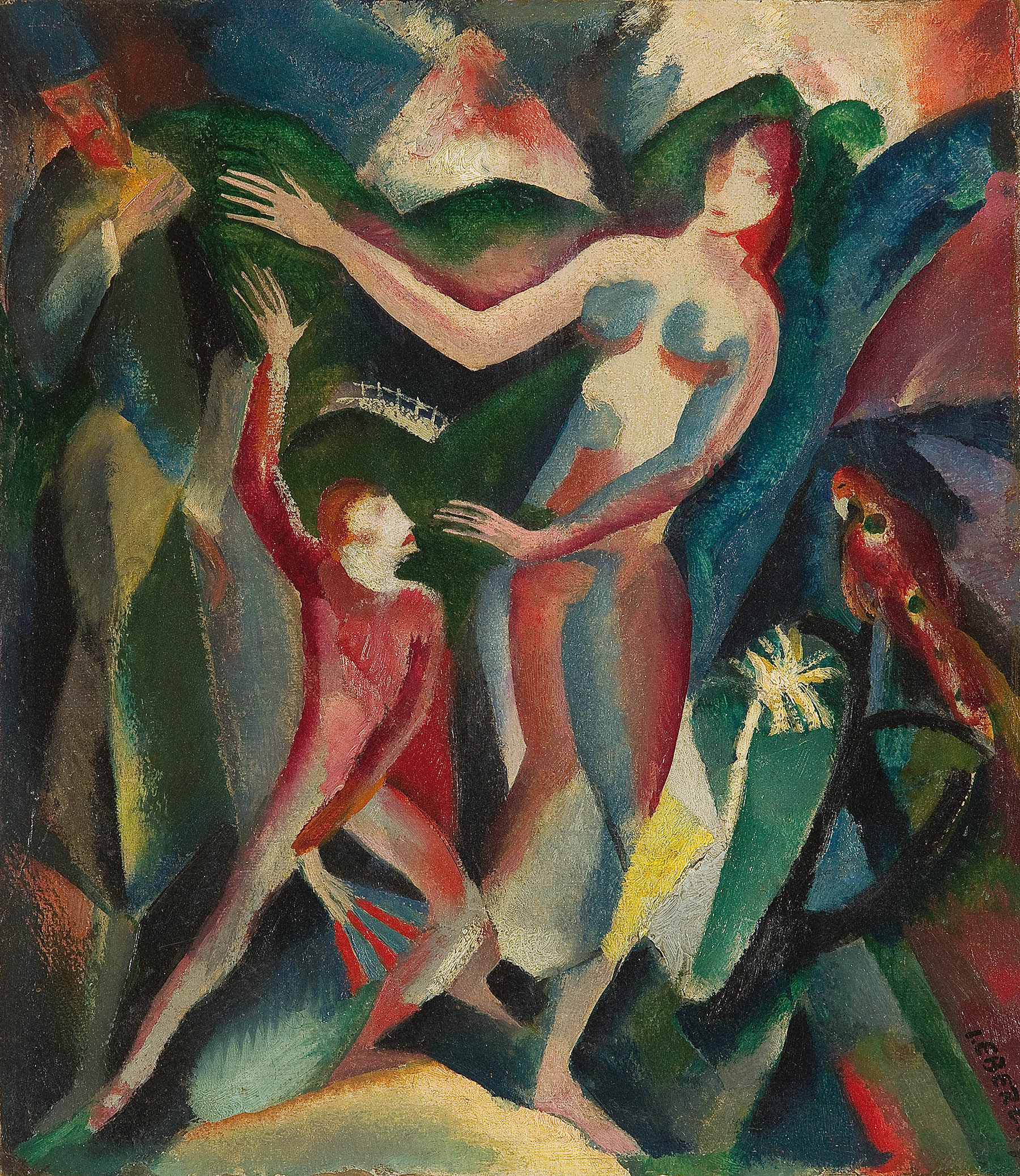
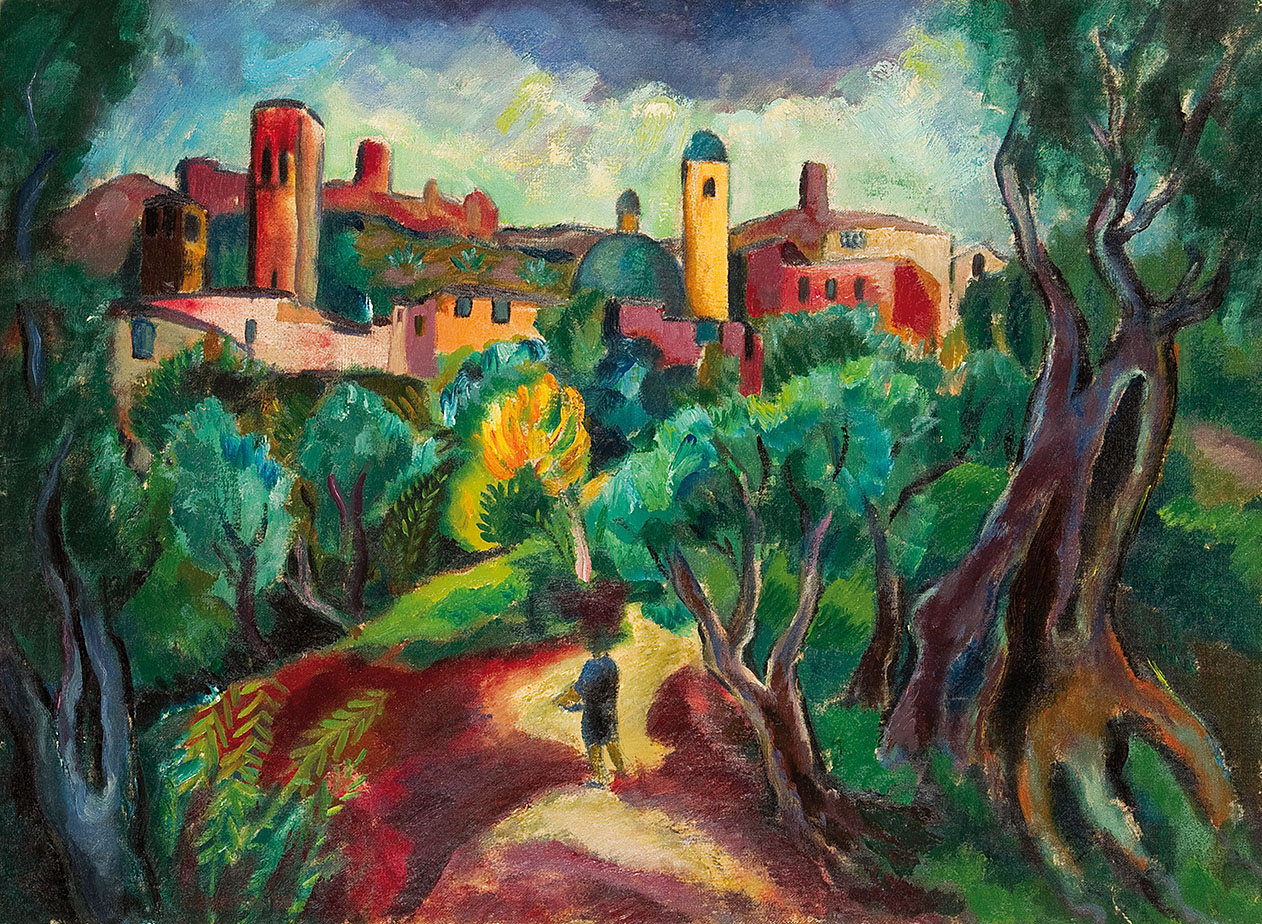




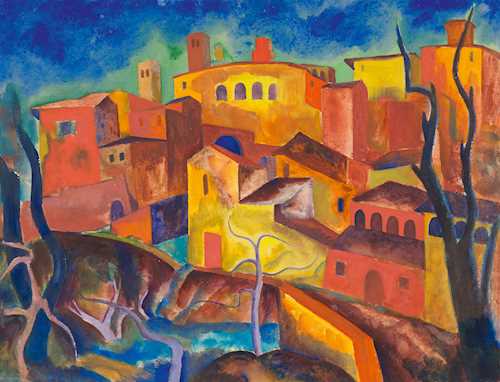
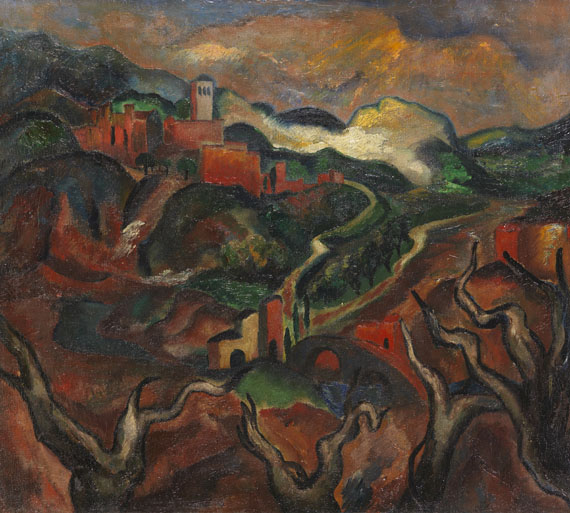
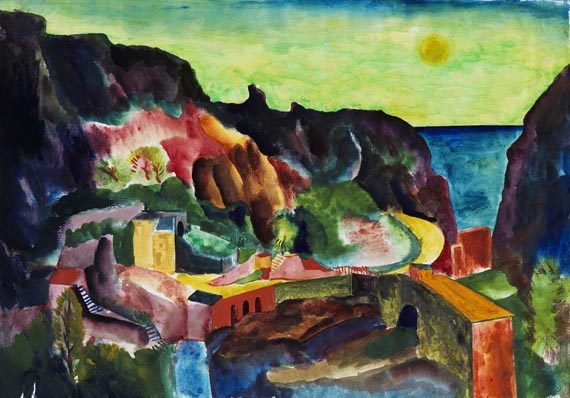
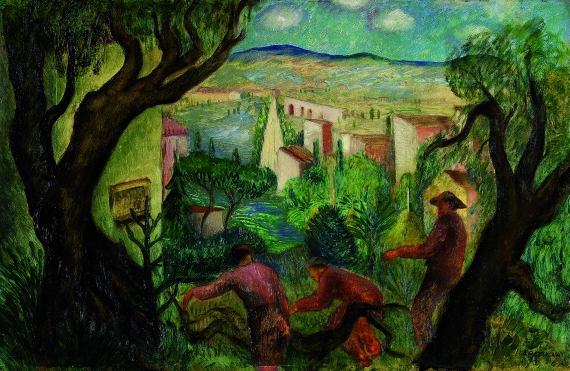

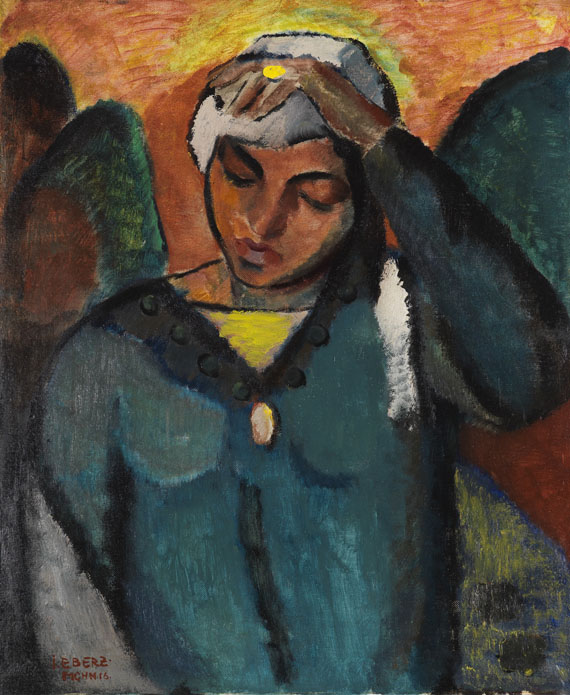
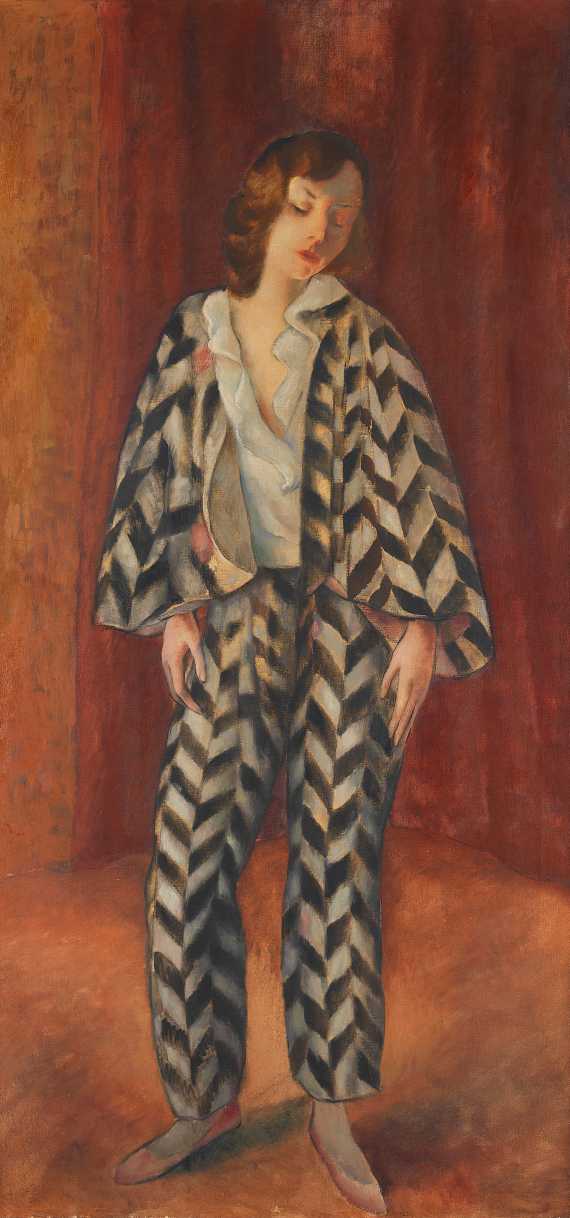

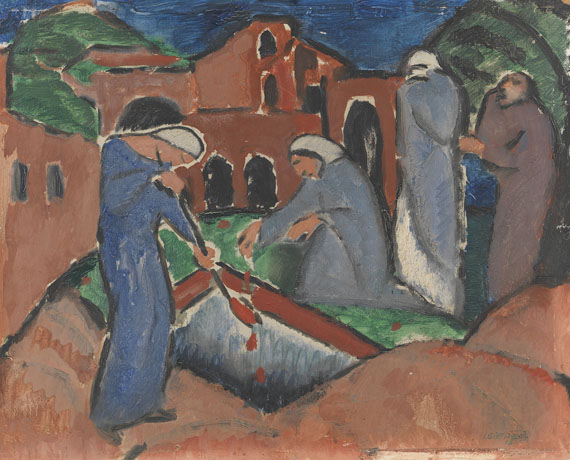
Testen Sie LotSearch und seine Premium-Features 7 Tage - ohne Kosten!
Lassen Sie sich automatisch über neue Objekte in kommenden Auktionen benachrichtigen.
Suchauftrag anlegen